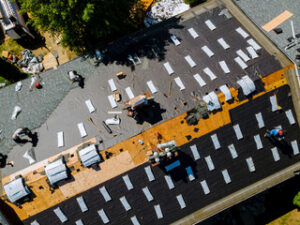Colorado Springs Roofing protect buildings and other structures from rain, snow, sunlight, and extremes of temperature. They can be constructed from a variety of materials and in a wide range of shapes.
Flat or low-slope roofs are water- and weather-proof membranes on slopes less than 3:12. Tile and slate roofs require specialized skills and materials to construct durable and visually appealing roofs.
There are a variety of materials used to cover the roof of your home. Each has its own advantages and disadvantages. Some are more expensive but last longer, and some are able to withstand extreme weather conditions.
Metal roofs are popular for their durability and longevity. They are suitable for flat or low-sloped roofs and can be installed with or without soldered seams. Metal roofs can be made of galvanized steel, aluminum, copper, or a terne metal alloy that combines zinc and aluminum. They can withstand extreme temperatures, are fire-resistant, and can withstand high winds.
Another durable roofing material is asphalt shingles, which come in many styles and colors. They are the most common type of residential roofing in the United States and can be found on a wide variety of homes. They are typically available in 3-tab and dimensional varieties, and premium shingles can be designed to mimic the look of other roofing materials such as slate or cedar shakes.
There are also various types of tile roofing. Slate, which is quarried from natural rock, can provide a beautiful, rustic look to your home. It has a lifespan of 75 to 200 years and is highly water- and fire-resistant. However, it is more expensive than other roofing materials and requires an underlying structure that can support its weight.
Other common types of tile roofing are concrete and clay. Concrete tiles are cheaper than clay but offer the same durability. They are available in a variety of shapes and colors and can be designed to mimic the look of other types of roofing materials, such as slate or cedar shakes.
Lastly, there are membrane roofs. These are made of large sheets that are fused together to form a single surface. The seams are sealed with hot or cold-applied adhesives. Membrane roofs can be installed on a variety of slopes and are generally resistant to UV rays, pests, and mold growth. They are also a good choice for environmentally conscious homeowners because they can be recycled at the end of their lifespan. Some membrane roofs are made of polyvinyl chloride (PVC) and thermoplastic polyolefin (TPO). Lastly, there are also synthetic roofing membranes, which are fabricated from polymer blends such as polypropylene and polyester.
Installation
Roofing is tough, physically demanding work. It takes a lot of time and is extremely dangerous for those not trained to do it properly. Check with the manufacturer of the roofing you want installed and ask for a list of credentialed contractors. Also look for local references, licensing, a solid Better Business Bureau rating, and active certificates of liability and workers’ compensation insurance.
Use this template to help guide your team through the steps required to install a new roof on a residential home. The process is well defined and includes form fields for progress monitoring and safety adherence. The overview spreadsheet provides a clear picture of the overall project status. The template is customizable to suit your needs. This template uses ActivityTimeline, the most advanced capacity planning and time tracking tool for Jira. Try it free for 30 days!
Maintenance
Maintenance procedures can help extend the life of a roof and minimize its overall life cycle cost. Repairs due to early deterioration caused by a lack of regular maintenance can be very costly and put interior valuables at risk. Untreated deterioration can also result in guarantee cancellation.
The roof surface must be kept free of debris such as leaves, trash, paper, etc. Debris restricts drainage, accelerates membrane deterioration, and can lead to localized ponding that can cause permanent damage. Regular surveys should be conducted to determine if the drainage system is working properly.
Routine roof inspections should be done regularly by trained roofing professionals, ideally on a biannual basis, to enable early problem detection and repair. This can save thousands of dollars in repair costs and service interruptions.
Industrial complexes often require more frequent roof inspections to maintain their roof systems due to the use of chemicals, exhausts, and residues from production processes that break down most types of roofing materials much faster than natural wear and tear. Leaks are common problems with industrial roofing, especially around penetrations. Regular inspections and maintenance can prevent leaks, reduce repair costs, and extend the service life of a roofing system.
Housekeeping surveys should be performed at least monthly on most roof areas to keep the drains open and identify potential damaging conditions. Generally, these surveys can be assigned to building mechanics who normally carry out day-to-day preventive maintenance duties, while more specialized or extensive repairs and those for roofs covered by an active warranty should be contracted to roofing professionals.
Replacement
If a roof becomes damaged beyond repair or you simply want to update your home’s appearance, roofing materials are available in a wide variety of styles and colors. Reroofing is best done during the spring and summer, when contractors are not as busy. In most areas, a permit is required for reroofing, and it’s important to work with a licensed contractor. Industrial complexes tend to take more abuse from chemicals, exhausts, and residues than residential properties, so their roofing materials wear down more quickly.
